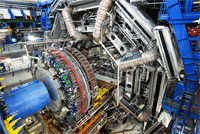
Big Science and the Gift that Keeps on Giving
The discovery of the Higgs Boson particle last year was hailed as the scientific breakthrough of 2012, but for those with a vested interest in big data, the project may be the gift that keeps on giving.
 So says Kyle Cranmer, a particle physicist at CERN, during a recent TED talk, explaining the importance of the research and the implications of it – which include not only fundamental breakthroughs in the way that we understand the universe, but also in how collaborative science is accomplished.
So says Kyle Cranmer, a particle physicist at CERN, during a recent TED talk, explaining the importance of the research and the implications of it – which include not only fundamental breakthroughs in the way that we understand the universe, but also in how collaborative science is accomplished.
“We are producing the biggest data set in the history of science,” says Cranmer, explaining the massive amounts of data being produced by the Higgs Boson research.
The researchers accelerate thin ribbons of protons through a 17 mile ring that tunnels underground just outside of Geneva, Switzerland. As the particles from these proton ribbons collide inside of the giant particle detectors built in enormous caverns underground, the detectors capture a type of digital image – 40 million times a second. Running for two years, that produces about a quadrillion digital snapshots of the collisions (for reference, that’s a 1 with fifteen zeros behind it).
“That’s how many grains of sand it would take to fill up an Olympic sized swimming pool,” comments Cranmer, who then goes on to discuss the data-mining challenge the scientists are faced with once they have their data set.
Imagine dipping your hand in water and then pressing it into the sand in that giant swimming pool, and embedding roughly a few thousand grains of sand on your hand. A few thousand is roughly the amount of Higgs Bosons they expected to make, says Cranmer. Now imagine painting those grains red, and then distributing them back randomly into the Olympic sized pool. “Our job,” says Cranmer, “is to go through and find those few red grains of sand.”
It’s an enormous challenge, says Cranmer, but they managed to do it and on July 4, 2012, they announced the discovery of the new particle.
But the story doesn’t necessarily end there, posits Cranmer. “There have been a lot of practical applications unanticipated practical applications from this type of curiosity driven research,” says Cranmer, suggesting that the big science statistical approach called “Collaborative Statistical Modeling” is one of the chief take aways from this discovery that will continue to produce results for science well into the future.
Cranmer explains that with thousands of collaborators all around the world looking for the Higgs Boson particle using divergent methods of discovery, a new statistical model had to be built to keep the discovery in order. The model itself is complicated, but the take-away is simple, suggests Cranmer. “This model is not specific to Higgs Boson – it’s technology developed for doing collaborative science, and it applies to all science.”
To conclude, Cranmer food for thought for individuals to consider as they ponder the implcations of this. “This web reminds me of another web,” explains Cranmer. “The world wide web was invented at CERN by Tim Berners Lee to help physicists to communicate with each other, and it definitely changed the world.
Related Items:
Midwest Growing Hub for HPC, Big Data






































